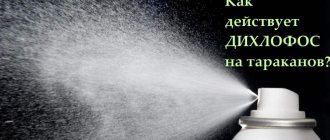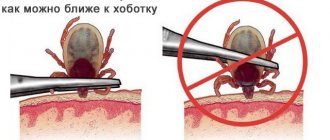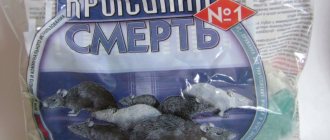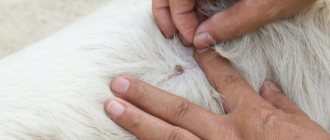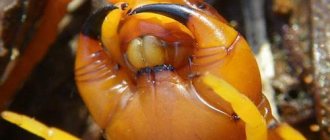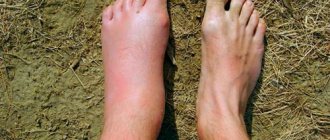Dogs are very inquisitive animals. And this character trait sometimes gets our dogs into trouble. A curious animal, having discovered an unfamiliar substance, may want to taste it. This is where the danger lurks - the substance may well turn out to be poison, and most often animal owners whose pets have tasted rat poison turn to veterinary clinics. Poisoning with this chemical is dangerous and difficult for a dog to tolerate: in the article we will tell you how a dog’s poisoning with rat poison manifests itself symptomatically, and we will find out what measures need to be taken to save the animal.
What is rat poison?
The term “rat poison” combines a group of rodenticides used for deratization purposes.
Russian consumers have access to such drugs as:
- Ratindane;
- Alpha-Naphthylthiourea or Krysid;
- Brodifacoum;
- Warfarin or Zookoumarin.
The drugs mentioned are relatively harmless to humans. The use of more dangerous rodenticides, such as strychnine, zinc phosphide, phosphorus, thallium-based compounds, arsenic and lead, is extremely rare. They are used only by dog hunters who deliberately poison stray cats and dogs.
How does rat poison affect a dog's body?
Anticoagulants, which are part of rat poison, contribute to disruption of the synthesis of phylloquinone, which is responsible for the regulation of blood clotting.
When its own reserves of vitamin K are used up, the poisoned dog develops multiple internal hemorrhages, leading to a quick and painful death. The dog also has damage to the respiratory, cardiovascular and central nervous systems.
Important! Zinc phosphide poisoning is also dangerous for the dog owner. Once in an acidic environment, this compound is transformed into a gaseous state and is easily removed from the body during bloating.
First aid kit
Experts have developed a special list of medications that should be in the home of every dog owner. Such items and medications will make the owner of a 4-legged friend fully prepared to provide first aid in case of poisoning. This list included:
- 3% peroxide solution;
- a set of syringes of different sizes, which are intended for washing the eyes;
- a rubber bulb necessary for cleaning the mouth;
- several packages of activated carbon;
- thermometer;
- numbers of veterinarians, emergency services for 4-legged animals.
Where can an animal find poison?
Most often, a dog finds poison on the street by swallowing poison-treated bait or eating an infected rodent.
Less commonly, toxins enter the animal's body through scratches and open wounds. This method of poisoning is more typical of puppies, who are often injured during play and love to explore all the objects they find.
Substances used
New generation rat poison baits do not contain arsenic, lead or strychnine. But modern poisonous substances for rodents are not completely safe for pets (in this case, dogs).
Modern manufacturers offer four types of bait, these are:
- first and second generation anticoagulants;
- naphthylthiourea;
- zinc phosphide.
All poisonous drugs are divided into two groups:
- the first act acutely, causing instant death. The option is ineffective in the fight against rats. Rodents are very smart, and if one animal dies after trying the bait, then the others will not eat it;
- baits with toxic substances of the second group have a subacute or chronic effect. Symptoms of poisoning appear some time after ingestion.
First generation of anticoagulants
The group includes warfarin, triphenacin, ethylphanacin. They are often used in the production of poisonous baits approved for household use.
Once in the body, the toxic substance leads to a deterioration in normal blood clotting. The disadvantage of this group is that rodents quickly become accustomed, so baits quickly lose their effectiveness.
Second generation of anticoagulants
The group includes:
- bromadiolone;
- flocumaren;
- brodiafacoum.
The effects of the listed substances are similar; they interfere with blood clotting. The difference from the first group is the retention in the body; toxic substances have a cumulative effect. Second generation drugs are more effective. Based on second-generation anticoagulants, the popular “Rat Death” bait is produced.
Naphthylthiourea
The poisonous substance naphthylthiocarbamide is sold under the name Krysid. Is highly toxic. If ingested, it causes convulsions, pulmonary edema, and death. It is used in the form of dry grain bait or gel.
Zinc phosphide
Baits based on zinc phosphide are classified as highly toxic. They are designed for professionals and are not sold in regular hardware stores. Zinc phosphide destroys the stomach of rodents.
The main symptoms and signs of rat poison poisoning in a dog
Signs of rat poison poisoning in a dog depend on the substance used to treat the bait.
When a pet is intoxicated with rodenticides, the following are observed:
- abdominal pain;
- weakness;
- lack of appetite;
- dyspnea;
- traces of blood in the urine;
- hyperthermia;
- bleeding from the anus, nose and gums.
Zinc phosphide poisoning is accompanied by:
- thirst;
- diarrhea;
- fainting;
- convulsions;
- breathing problems;
- severe weakness;
- loss of coordination.
When a dog is poisoned by a rat, the following is observed:
- vomit;
- slow pulse;
- anuria;
- dyspnea;
- pulmonary edema.
Important! Symptoms of rat poison poisoning in a dog can appear one at a time. Therefore, at the slightest suspicion of intoxication, the animal must be urgently taken to the veterinary clinic.
Consequences
Poisoning with rat poison in a mild form and with prompt medical care usually goes away without a trace for dogs. Apart from several days of depressed mood in the animal and lack of appetite.
If the intoxication is significant, complications associated with liver function most often occur. In particular, the liver begins to have problems regulating blood clotting. For this reason, hemorrhages are so common when poisoned by rat poison. If the liver is severely damaged, death is likely.
For preventive purposes, do not let your dog off the leash while walking, especially if you are near old buildings with basements, attics, and warehouses. Read announcements from utility companies and sanitary and epidemiological stations: the time and place of large-scale pest control are usually warned in advance.
We learned what danger rat poison poses to dogs, and what can be done if your pet is poisoned by this substance. Rat poison can not only have a negative impact on the health and well-being of the dog, but can also lead to the death of the animal. To protect your dog from poisoning, take precautions when walking, and immediately take your pet to the clinic at the first signs of intoxication.
Currently reading:
- Seven Signs and Remedies for Getting Rid of Fleas in Dogs
- Thyroid dysfunction in dogs (hypothyroidism)
- What to do if your dog has an abnormal bite
- First aid for a dog if it is poisoned
What to do if your dog has eaten rat poison
In case of rodenticide poisoning, the dog is given emergency care aimed at inhibiting the absorption of the poison and speedy detoxification of the body.
How much time do you have for rescue?
If a dog swallows rat poison bait, he has only 2 hours to save him. After the specified time, toxins affect most of the internal organs, and the probability of a fatal outcome increases to 85%.
First aid
In case of poisoning with rat poison, the dog is given a gastric lavage with a solution made from a glass of heated water and 1 tbsp. l. salt. The liquid is poured into the animal’s mouth with a syringe without a needle, and then lightly pressed on the base of the pet’s tongue to trigger a gag reflex. Experiments with other ingredients, such as medicines, herbs and potassium permanganate solution, can cause burns to the mucous membranes or allergies.
Important! Gastric lavage is prohibited in case of intoxication of unknown etiology, loss of consciousness and gastrointestinal bleeding, which is accompanied by vomiting of black masses and coughing.
To wash the intestines of a dog suffering from rat poison poisoning, give an enema of 50-100 ml of clean water. The procedure is carried out until clean water flows from the anus. A contraindication for performing an enema is the presence of bloody impurities in the excrement.
To prevent dehydration and reduce the concentration of toxins, 5 ml of clean water is poured into the dog’s oral cavity every quarter of an hour.
On a note. Giving your dog a mixture of vodka and raw eggs is only allowed as a last resort. This effective folk remedy provokes numerous consequences, to eliminate which you need to arrive at the veterinary clinic no later than half an hour in advance.
Medicines you need to have in your first aid kit
Every dog owner’s personal first aid kit should contain the following items to provide emergency assistance to an animal affected by rat poison:
- antidote for rodenticide poisoning (Vikasol, solution of copper sulfate or tannin);
- sorbents (activated carbon, Polysorb, Enterosgel or Smecta).
The dosage of drugs is selected taking into account the weight of the dog. If you have doubts about the correctness of the calculations, it is better to consult a veterinarian.
Antidote elements
When an animal is affected by anticoagulant elements, the only true salvation is the urgent administration of vitamin K1 - phytomenadione, which must be administered subcutaneously. The dosage depends entirely on the weight of the animal.
There is no specific antidote for rat infection. To save the victim, intensive tannin feeding is practiced. This element specifically binds all toxins in the stomach.
To save someone poisoned by a rat, you will need to immediately feed the victim with copper sulfate or soda.
In such a situation, it is extremely important to provide qualified assistance to the poisoned person in a timely manner. It is important to identify the type of poison and distinguish poisoning from hematological diseases. Only an experienced doctor can make a final diagnosis and prescribe adequate, comprehensive therapy.
Often, when blood vessels are damaged, doctors prescribe complex therapy. It includes:
- Long-term course of taking vitamin preparations with K1. The duration is sometimes up to 5 weeks. It all depends on the severity of the condition, data from objective examination methods and laboratory blood parameters.
- During the first hours after poisoning, it is advisable to perform a blood transfusion. In difficult situations, a transfusion is required for the dog. The technique allows you to restore the concentration of red blood cells and compensate for the deficiency of coagulation factors.
- We must not forget about symptomatic therapy: victims are always prescribed anticonvulsants and heart medications. If necessary, hepatoprotectors, diuretics and sorbents are added. The combination of medications is always selected individually - it all depends on the complexity of the condition and the body’s response to therapy.
Professional treatment
The dog ate rat poison: treatment for the dog
If poisoned with a small amount of rat poison, gastric lavage, sorbents and laxatives are enough to save the dog. Usually, within a few hours after applying these measures, the dog’s condition returns to normal, and after a few days, the symptoms of intoxication completely disappear.
In difficult cases, the dog is given a blood transfusion and vitamin K is injected subcutaneously. Then the animal is left in the hospital and its well-being is monitored for several days. After administering an antidote, the choice of which depends on the type of toxin, the dog is prescribed symptomatic treatment aimed at eliminating the consequences of poisoning.
In complex therapy, the following are usually used:
- sorbents;
- diuretics;
- antibiotics;
- painkillers;
- corticosteroids;
- heart medications;
- anti-inflammatory;
- salt-based laxatives.
In case of zinc phosphide poisoning, the dog is prescribed Maalox, which helps remove toxins from the body.
In case of severe intoxication, the course of treatment can last up to 30 days, during which the dog is systematically administered an antidote and given a blood transfusion.
Caring for your dog after poisoning
After stabilizing the animal’s condition, you must strictly follow the specialist’s recommendations regarding feeding and caring for the pet. Recommendations may vary depending on the degree of damage to internal organs. In the first day after poisoning, the animal should have constant access to water, but you should not feed the dog. This will reduce the risk of overloading the kidneys and liver, and quickly remove toxins from the body.
Daily feeding rate
After a day, on the doctor’s recommendation, you can start offering your pet liquid porridge or light broth in small portions. The animal needs to be fed up to 5 times a day. For the entire recovery period, you should avoid eating canned dog food, dry food, pasta, bread, potatoes and other foods that will be difficult to digest.
Gentle feeding is indicated for the animal for a month after poisoning. Products should be introduced into the diet gradually. The first time after poisoning, the pet will experience pain and severe weakness, so you should not overload it with long walks and training. A gentle regimen will allow your pet to recover faster from intoxication.
What not to do if poisoned
In order not to aggravate the condition of a dog suffering from rat poison poisoning, it is prohibited:
- Induce a gag reflex in the animal if more than 3-5 hours have passed since the poisoning. By this point, the contents of the pet’s stomach have managed to get into the intestines and artificially induced vomiting will not only be useless, but will also weaken the body even more. Also, this method cannot be used for convulsions, paralysis and loss of consciousness.
- Give your dog eggs, vegetable oil, milk and castor oil. When in contact with zinc phosphide, they aggravate the negative effects of the poison and contribute to the accelerated release of toxins into the blood.
Important! If a dog is poisoned by rat poison, the pet should not be given strong human medications. First, humans and animals have different dosages. Secondly, it is unknown what reaction will occur when the poison comes into contact with the medicine.
Where can a dog get poisoned?
Rat bait has an attractive taste - otherwise smart rodents would not eat it. Therefore, animals can accidentally eat poisonous poison. If the owner is inattentive or careless when treating the area, the poison may end up where the dog walks. Out of curiosity, she may try the “treat.”
A dog can become poisoned accidentally if it ends up with its owner on the premises or in a room that has been treated for rodents. The owner may not even know about it.
If an animal eats a poisoned mouse or rat, some of the poison will enter the dog's body. Sick rodents move slowly, so they often become easy prey for pets.
It happens that dog hunters and neighbors dissatisfied with the loud barking of their dogs also use rat poison. A poison that has an attractive taste can be perceived by an animal as a delicacy, and it will enjoy it with pleasure.
Animal restoration
During the recovery period, the animal is recommended to:
- Special food. A dog that has suffered from rat poisoning is kept on a starvation diet for 24-48 hours. Then slimy porridges (oatmeal or rice), boiled vegetables, lean meat broths and fermented milk products with a fat content of up to 1% are introduced into her diet. The dog is fed in small portions 5-6 times a day, and all food is given in ground or liquid form. If the dog eats dry food, he is transferred to a veterinary line designed for animals with diseases of the digestive system.
- Special care and walking. At first, the injured dog can relieve itself on its own, so it is recommended to cover its bed with hygienic diapers. It is also advisable to increase the number of walks and reduce their duration.
During walks, it is recommended to protect the dog from communicating with other people’s pets and not to overload it with physical exercises.
We recommend reading:
- Signs and treatment of piroplasmosis and the danger of ticks for dogs
- Diarrhea and vomiting in dogs
Will mouse bones harm my dog's intestines?
Like most birds, mouse bones are very tiny and will likely be able to fit through without causing any obstruction or perforation. The bones you really need to worry about are the cooked bones. However, it is always wise to be aware of the possibility of a problem occurring. Typically, a blockage occurs when your dog eats something too large to pass through the intestines.
Signs of a blockage include vomiting, diarrhea, changes in appetite, or abdominal pain that lasts more than 24 hours. If you are concerned, contact your veterinarian and they can advise you if any immediate treatment is required.
How to protect an animal from poisoning
The recovered dog becomes more susceptible to repeated poisoning by rat poison and the next time the animal may die.
To protect your pet from potential danger in the form of bait with rodenticides, it is recommended:
- Take a responsible approach to choosing dog walking locations. It is advisable to stay away from food processing plants and city landfills, where pest control is often carried out. It is also recommended to avoid parks, squares and playgrounds where dog hunters usually leave poisonous baits.
- Before going for a walk, put a leash and muzzle on your dog.
- Train your dog. You should not allow your pet to pick up scattered food or take treats from the hands of strangers. If raising your pet on your own does not bring the desired results, it is better to use the services of a professional.
Important! When baiting rodents yourself, it is recommended to store poisons so that the dog cannot reach them.
Bromethalin and antidotes
Bromethalin is a dangerous substance that causes swelling of the brain in animals. Its action is often similar to drugs that interfere with blood clotting. The substance disrupts the functioning of the nervous system by increasing the permeability of protective cell barriers. This action leads to the death of the dog. Bromethalin poisoning is characterized by the presence of specific symptoms.
Symptoms:
- Uncoordinated paw movements;
- Convulsions;
- Neurological disorders;
- Muscle paralysis;
- Death;
The rate at which symptoms develop depends on the amount of the substance eaten. The first symptoms are observed after a couple of hours, but a long period of development of an overdose is possible - up to thirty-six hours. Therefore, it is recommended to monitor the animal if there is a suspicion that the dog has eaten a rat or mouse.
At the moment, there are no antidotes to combat such poisoning. The injured animal is given a large volume of activated charcoal and a thorough gastric lavage is performed. It is recommended to use diuretics to reduce the likelihood of swelling in your pet.
You will like the article: “ How salmonellosis manifests itself in dogs - the first symptoms and methods of treatment .”
Bromethalin is less dangerous for dogs than for cats. However, when producing poison, poisoning options are taken into account and the dosage is calculated so that only the rodent is harmed. If the substance is ingested by any animal, immediately show it to a veterinarian.
